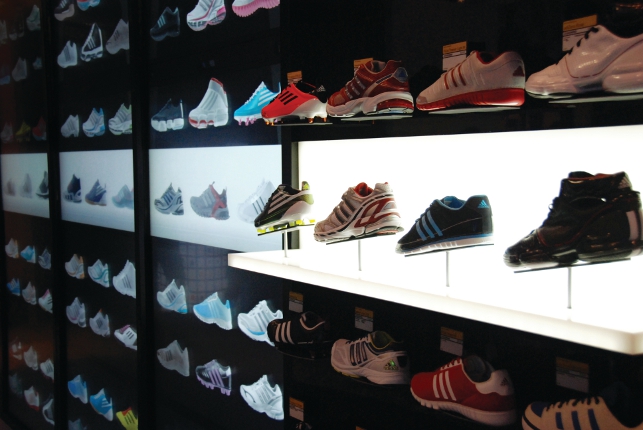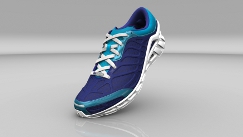The design and development process can be a lengthy endeavour for any company but imagine being a global organisation with thousands of new products launched each year.

The adidas virtual footwear wall features touchscreen and realtime 3D rendered products
For instance, adidas is working on its Spring/Summer 2013 collection, which consists of over 40,000 individual articles.
“It’s amazing how ever shorter cycles, the steady increase of portfolio and channel complexity, and of course the rise of margin pressure, as well as development cost and not at least the innovation-thriving customers, gradually encourage the fashion industry to move away from traditional processes.
The next level of this evolution – to me – clearly is virtualisation, which is changing the game completely,” says Detlef Mueller, adidas senior manager creation technologies.
Virtualisation has become a key strategic programme at adidas and consists of visualising all products in 3D far earlier in the design process. “Essentially, virtualisation is a programme about using virtual assets at every stage with the aim of having a completely virtual product lifecycle,” says Mueller.
New design process
Like most product manufacturers, adidas’ design and development process is fairly traditional starting with 2D sketching and concept generation through to engineering, prototyping and production.
“Some of the challenges the industry faces in a traditional design process are the high number of expensive physical prototypes and the time loss that is necessary to send out physical pieces of the collection around the world,” he describes.
“Furthermore, to discuss the different design steps with all the people involved in the process that are located in different countries brings up all kinds of communication and cultural topics. So, we needed to narrow the space for interpretation in order to be efficient.”
Virtualisation will ensure that the number of physical prototypes are reduced with more decisions on the look, colours, materials and silhouettes being made on the virtual prototypes instead.
In order to achieve this, a project has been introduced within adidas’ virtualisation programme called ‘3D Design’, which will see all designers involved in the design process working in 3D.
Currently, adidas uses a number of tools in its process including 3D visualisation software DeltaGen from software provider RTT.
“DeltaGen offers us the most efficient and convenient way to quickly bring our ideas to life at best-in-class quality, while it’s tightly integrated with our PLM (Product Lifecycle Management) systems,” says Mueller. “At the same time, RTT is a strategic partner that supports us in shaping our future processes to stay ahead of the game.”
Footwear wall
So, DeltaGen is key to adidas’ virtualisation programme and the two companies are currently working together on the creation of 3D files that can be used in a number of applications, including the Virtual Footwear Wall.
Consisting of multiple LCD touch screens and using real-time 3D rendered products, this virtual wall can be placed in any retail store. Customers can select shoes on a virtual shelf by touching the one they want to look at and then rotate and zoom in.
They can also find out more information about a particular shoe’s benefits, background and also discover what others are saying about it before proceeding to the checkout.
“The Virtual Footwear Wall transforms the entire customer experience on how to perceive and select a product,” says Mueller. “Based on the limited physical space available, our stores are not able to present the entire portfolio to the customer and this results in lost opportunities for us.
Now we can offer the entire portfolio virtually in a thrilling and seamless experience. Even more, we can sell products virtually that do not even exist yet.” In order to create this virtual wall, adidas needed high quality 3D rendered images of its products.
“Hundreds of products will be visible at the same time and that means the 3D files created in DeltaGen are much too big. We did some tests at the beginning and if we tried to put more than four shoes into the game engine it would crash.
A solution would be to use clusters but this isn’t suitable for a retail environment. So the idea was basically to find a solution to feed this virtual footwear wall,” says Mueller.
The problem they had is that 3D files, unlike 2D files, cannot be easily downsized and used in a range of applications. “A 3D file contains information on geometry and material but you cannot transfer material from one 3D application to another without losing quality.
For the footwear wall we needed a really low resolution file and we needed to transport all the information without this loss of quality,” he explains.
Universal 3D file
adidas is about to establish a solution for producing universal 3D files that can be transferred into almost any other 3D application. “To explore all these new opportunities we need to be as versatile as possible, because we need to be prepared to collaborate seamlessly with all of our current and future partners.
So we required a compatible format we can easily share while ensuring the consistent look and feel of our brand,” says Mueller.
This universal 3D file was achieved by using new modelling and texturing techniques including texture baking to reduce the number of textures in a 3D rendering.
“The material system in a shoe, for instance, is very complex as there are many layers of materials. So, with this technique we can bake everything into standard textures. You can still see the detail even every stitch but if you look at the geometry, it’s all baked textures.”
So, these reduced 3D files can now be used in a range of applications including the virtual footwear wall. A pilot project is taking place with this wall currently installed in the adidas flagship store in London’s Oxford street.
“The wall provides a more consumer and media-adequate way of product and brand experience and is not only limited to selling, but offers a myriad of ways to explore the Adidas Universe for our customers,” says Mueller.
Virtual future
Another area where this 3D file will be very beneficial is during the product sell-in. “Traditional sell-in consists of thousands of products in a show room and people sit there for days trying to merchandise their ranges.
https://youtube.com/watch?v=dvr0q7bW-UU
Traditionally, with t-shirts, for instance, all the samples showing the different colourways had to be present but with the virtual sell-in you only need one sample available in the show room. So customers can touch that one but then see colours virtually.”
adidas is certainly on its virtualisation path but according to Mueller, it’s still early days. “Although virtualisation will not only impact the development but also the marketing, selling and retailing of our collections; when it comes to the entire potential of virtualisation, we are still at the very beginning of this evolution.” 
Collaboration enables adidas to offer virtual personalised footwear design
Default








